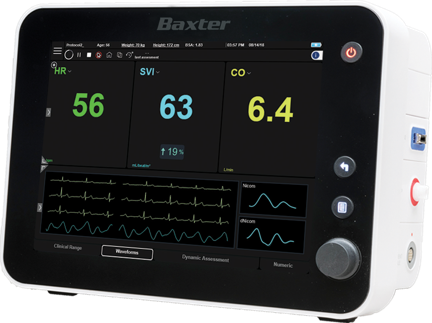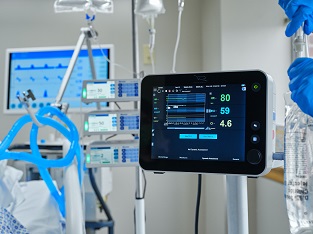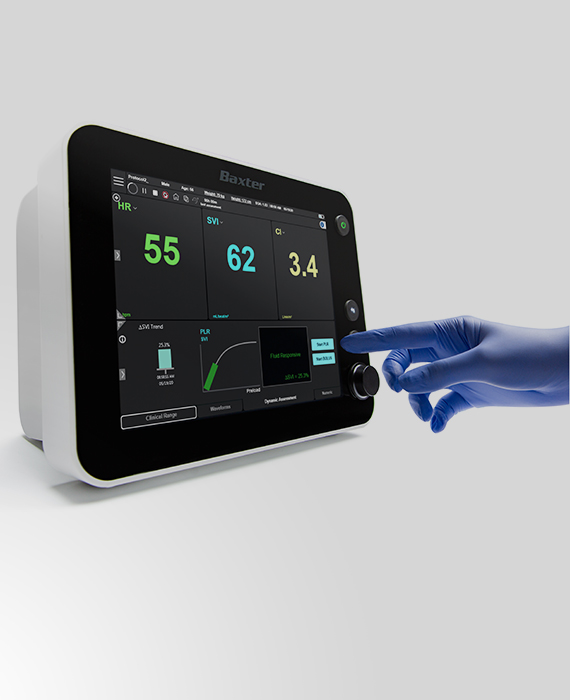Starling Fluid Management Monitoring System
The Starling system is available in select countries globally.

Using patented Bioreactance technology, the Starling Fluid Management Monitoring System represents the latest advancements in hemodynamic monitoring, providing easy-to-use, non-invasive technology that delivers accurate and precise data that takes the guesswork out of fluid assessment. The Starling system advances efforts to shift treatment away from a one-size-fits-all approach toward individualised, patient-specific clinical decisions to help healthcare professionals deliver the right therapy to the right patient, every time.

Proper Fluid Management Is Critical, But Fluid Responsiveness Is Dynamic
Over 80% of hospitalised patients receive IV fluids.1 Yet despite the importance of fluid therapy, studies show administering too little or too much fluid can lead to serious complications and contribute to rising healthcare costs.2,3
Every patient has unique and constantly changing fluid management needs, and fluids should be dosed according to patient response. Assessing whether fluid may help or harm a patient is a critical step in optimising treatment for the individual patient – only about 50% of hemodynamically unstable patients will respond to IV fluid by increasing cardiac output and perfusion.4 The Starling system can provide the information a clinician needs to determine whether a patient will benefit from additional fluid.

More Informed Clinical Decision-Making
The Starling system offers an accurate, reliable and non-invasive method to measure blood flow at the patient’s core and deliver meaningful insights to guide clinical decision-making. Using unique Bioreactance technology, it provides a full hemodynamic profile within seconds, with 94% sensitivity and 100% specificity for predicting fluid responsiveness in critical care situations.5

Use the Starling System Throughout the Hospital
With easy setup and no invasive lines, the Starling system delivers quick access to real-time data to help improve diagnostic precision and facilitate fluid management treatment wherever the patient is in the hospital. It supports clinicians in the operating theatre, the emergency department, the ICU and the rapid response team.
The Starling system works in both mechanically ventilated and spontaneously breathing patients,7,8 with no requirement to upgrade or change the monitor depending on the severity of illness. It is designed to travel with the patient and support the various healthcare teams on their care journey.
100% non-invasive
Supports individualised fluid therapy without requiring an invasive arterial or central line, potentially reducing the risk of hospital-acquired infections and other complications6
Easy-to-perform dynamic assessments
The Starling monitor guides clinicians through a step-by-step protocol for executing a passive leg raise or bolus test
Watch How It Works
Real-time, continuous information
Provides real-time, continuous information on cardiac index, cardiac output, stroke volume index, stroke volume and total peripheral resistance
Improved Patient Outcomes and Potential Cost Savings
There are over 100 peer-reviewed publications for Starling. The use of stroke-volume-guided resuscitation to improve patient outcomes was demonstrated in the FRESH (Fluid Responsiveness Evaluation in Sepsis-associated Hypotension) prospective multi-center study9 and an earlier retrospective single-center study and subsequent economic analysis by the University of Kansas Health System.10,11
Improved Patient Outcomes in FRESH Study9
-1.37 L Decreased
Fluid Balance at 72 Hours
-48% Reduced Risk of
Mechanical Ventilation
-12.4% Reduced Initiation of
Renal Replacement Therapy
+20% More Likely to Be
Discharged Home Alive
Improved Patient Outcomes in University of Kansas Studies10,11
-2.89 Days Reduced
Length of Stay in ICU
-51% Reduced Risk of
Mechanical Ventilation
-13.25% Reduced Initiation of
Acute Dialysis
+$14K Potential Savings
Per Treated Patient
For safe and proper use of the product mentioned herein, please refer to the appropriate Operator's Manual or Instructions for Use.
CE 0482